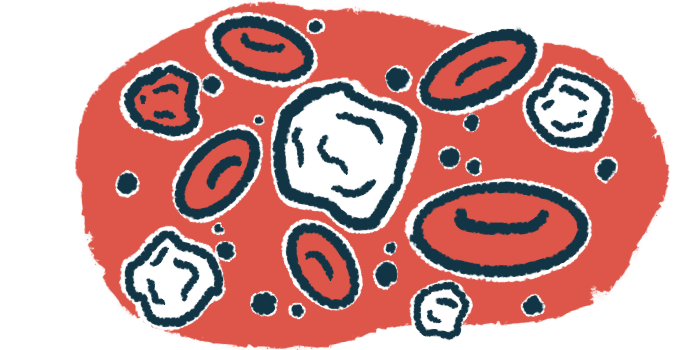In NMOSD, Enspryng promotes B-cells’ anti-inflammatory profile
Findings suggest 'regulatory profile' change may be new mechanism of action
Written by |

Enspryng (satralizumab-mwge) promotes an anti-inflammatory profile in plasmablasts, the immune cells that produce large amounts of the self-reactive antibodies that drive most cases of neuromyelitis optica spectrum disorder (NMOSD).
That’s according to a study analyzing immune cells from NMOSD patients before and after treatment with Enspryng, as well as its effects in lab-grown immune cells derived from patients and healthy people. The findings suggest the transition to a so-called regulatory profile, which is associated with anti-inflammatory and immunosuppressive effects, may represent a new mechanism of action of Enspryng, the researchers said.
“The essence of autoimmune diseases is a breakdown of autoimmune tolerance, the system that prevents us from attacking our own bodies,” Norio Chihara, MD, PhD, one of the study’s first authors at the Kobe University Graduate School of Medicine, Japan, said in a university press release. “Our ultimate goal is to cure the disease by restoring this autoimmune tolerance, and the results of this study show one aspect of our work towards this goal.”
A unique characteristic of these regulatory plasmablasts was the increased production of the CD200 anti-inflammatory protein, which may serve as a biomarker for Enspryng treatment responsiveness in NMOSD patients.
The study, “Interleukin-6 Signaling Blockade Induces Regulatory Plasmablasts in Neuromyelitis Optica Spectrum Disorder,” was published in Neurology Neuroimmunology & Neuroinflammation.
NMOSD is a rare autoimmune disease marked by inflammation of the spinal cord and optic nerve, which sends and receives signals from the eye, resulting in recurrent attacks and accumulated disability, including vision loss and paralysis. Most cases are driven by self-reactive antibodies produced against the protein AQP4. High amounts of antibodies, including those against AQP4, are produced by plasmablasts, the short-lived mature form of immune B-cells.
“B-cells are a type of key immune cell that respond to inflammatory signals, and in autoimmune diseases like NMOSD, they produce antibodies against part of the body itself, exacerbating the condition,” Chihara said.
Enspryng’s effect on plasmablasts
NMOSD patients have high levels of plasmablasts in their blood and cerebrospinal fluid (CSF), which surrounds the brain and spinal cord, and these have been linked with disease activity. Patients also have elevated blood and CSF levels of interleukin-6 (IL-6), a pro-inflammatory signaling protein that promotes antibody production in B-cells and prevents immune T-cells from transitioning to a regulatory, anti-inflammatory profile.
Enspryng, which is designed to block the receptor protein for IL-6, is approved to reduce relapses in adults with NMOSD who test positive for anti-AQP4 antibodies. Its IL-6 blockade doesn’t entirely abolish B-cell maturation, however.
“Since we observed that B-cells were still present in the blood of patients after treatment, we decided to investigate the possibility that they were changing into a different type of B-cell,” said Chihara, who, with his colleagues, analyzed B-cells from 31 NMOSD patients with anti-AQP4 antibodies, and from 33 age- and sex-matched healthy people, who served as controls.
The researchers confirmed that plasmablast counts increased in NMOSD patients during acute attacks relative to healthy controls and decreased during remission. Another B-cell subtype — double-negative B-cells, or DNs — followed similar trends.
Focusing on the 10 patients treated with Enspryng, the researchers found the proportions of whole B-cells, plasmablasts, and DNs remained unchanged after treatment, suggesting Enspryng instead altered B-cell characteristics.
Immune cells from the healthy controls and patients in remission were then isolated and stimulated in the lab to mimic an NMOSD attack. There was a marked expansion of plasmablasts and DNs, as seen during NMOSD attacks.
Exposing these stimulated cells to Enspryng increased the production of interleukin-10 (IL-10), a potent anti-inflammatory protein that’s primarily secreted by regulatory B-cells, which are important for maintaining immune balance and preventing autoimmune responses.
The IL-10 boost occurred in plasmablasts, but not DNs, suggesting Enspryng “induces a regulatory function within the underlying mechanism by which B-cells [mature] into [plasmablasts],” the researchers wrote.
Enspryng also increased the activity of a gene that encodes CD200, an anti-inflammatory protein whose role in NMOSD remains unclear.
In both healthy controls and NMOSD patients, plasmablasts positive for CD200 produced more IL-10 than those without CD200, suggesting CD200 may be a “cell surface marker of regulatory [plasmablasts].”
Consistently, the proportion of CD200-positve plasmablasts among immune cells from NMOSD patients was significantly higher during Enspryng-induced remission than during attacks. No such differences were found for whole B-cells or other B-cell subsets.
“The regulatory [plasmablasts] found in our study might be one target for future therapies,” the authors wrote. “Our findings suggest that the induction of regulatory [plasmablasts] represents a novel mechanism of action for NMOSD treatment through the IL-6 signaling blockade.”






